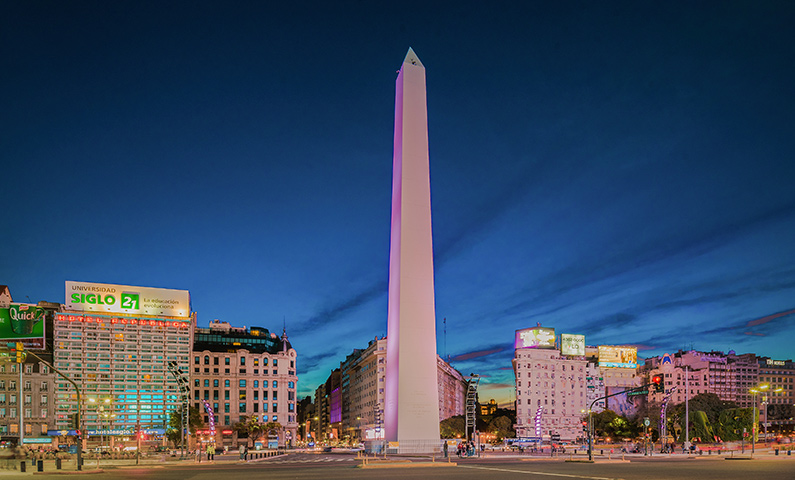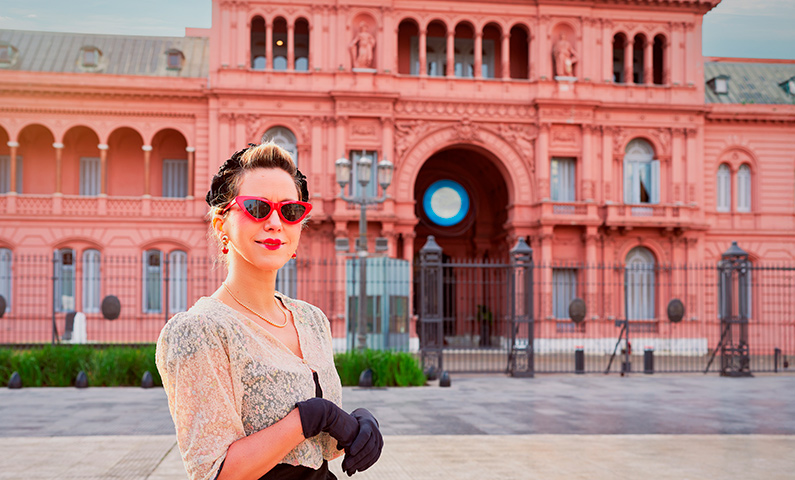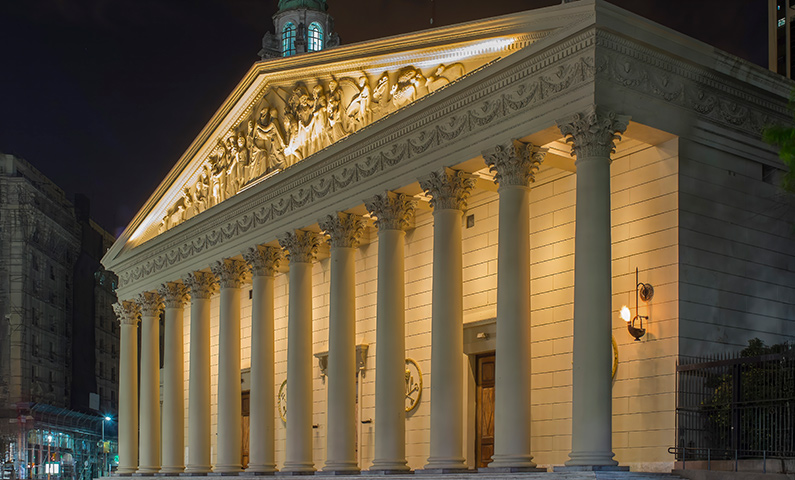If you are visiting Buenos Aires, you must take advantage of this characteristic and emblematic monument. Located at the intersection of Corrientes and 9 de Julio, two of the main avenues in the city centre, you will find endless entertainment proposals and many tourist attractions in its surroundings. Ready for the tour?
The intersection of Corrientes Avenue, bursting with theatres, pizzerias and points of interest; and Avenida 9 de Julio, the world’s widest street, is where the famous Obelisco de Buenos Aires is erected. The location was chosen for the importance of the streets and the exact place where the Argentine flag was raised for the first time in Buenos Aires.

Obelisk of Buenos Aires. Photo: shutterstock.com
On May 23 1936, the Obelisk was inaugurated, coinciding with the celebration of the fourth centenary of Buenos Aires’ first foundation, carried out by Pedro de Mendoza, which reaffirms the symbolic nature of this landmark.
A year later, after complex construction works, Avenida 9 de Julio was inaugurated. Although the project started at the end of the 19th century, it had to face difficulties such as the acquisition of nearby land, financing and planning in terms of urbanism.
It is worth mentioning that Avenida 9 de Julio, one of the most important urban highways in the City of Buenos Aires and one of the most iconic in the country, was only 500 meters long at the time of its inauguration. It is connected to Viamonte and Bartolome Mitre St.
Along its three kilometres, at present is presently connecting Libertador Avenue with Constitution Square.
Structure of the Obelisk
The Obelisk is the work of architect Alberto Prebisch, one of the main exponents of Argentine modernism and also the author of the Gran Rex Theatre, located on Corrientes Avenue, metres away from the monument. The construction was carried out in record time, since in just 31 days the German company Siemens, which was in charge of building the monument, completed the work 9 days ahead of schedule.
With a total height of 67.5 metres and a base of 6.8 metres per side, the Buenos Aires Obelisk stands in the Plaza de La República, also a meeting point for local artists. On each of its 4 sides, there is a plaque commemorating different Argentine historical events: the first founding of Buenos Aires in 1536, by Pedro de Mendoza; the second foundation in 1580, by Juan de Garay; the first hoisting of the national flag and the proclamation of Buenos Aires as capital city.
Obelisk’s only entrance door is located west-facing Corrientes Avenue, although it is not open to the general public. Inside the monument, there is a marine staircase with 206 steps and 7 landings that leads to the top. The spot features an incredible viewpoint with four windows and a lightning rod that cannot be seen from the street.
Places to Visit Near the Obelisk
Colon Theater
Colon Theater has international recognition, both for its architectural beauty and for the quality of the artists it has hosted for so many years.
Opened in 1908 after 20 years of construction, It is considered one of the five best opera houses in the world. Recognized for its acoustics and the artistic value of its architecture, symphonic concerts and classical dance are currently also exhibited.
Guided tours can be made within the Colon Theater, taking you through the Main Hall (stalls or boxes), the Main Foyer, the Bust Gallery and the Golden Hall. Visitors will discover amazing details about the architecture, the stairs, its sculptures and stained glass.
Visits take place every day and last approximately 50 minutes. They start at 11 in the morning and start every 15 minutes. The last visit commences at 4:45 p.m. There are also two daily tours in English at 1 and 3 p.m.
Cerrito 628, San Nicolás.
Corrientes Street
One of the most famous in the city for its down-to-dark activities, this is one of the avenues that leads to the Obelisk Some of the most recognized and important theatres halls in the City of Buenos Aires are located on Corrientes Avenue, or Corrientes Street as it is also known.
The Avenue can be considered an open-air cultural centre, since in addition to its artistic offer and nightlife, it has a rich history.
Corrientes Avenue begins in Puerto Madero and ends in the Chacarita neighbourhood, going through the Balvanera neighbourhoods (once Abasto, where the popular Shopping Abasto is placed), Almagro and Villa Crespo districts are linked to the history of tango and its golden age, as well as to Buenos Aires culture. In fact, both in places on this avenue and in its surroundings you’ll find bars, theatres and nightclubs where the great musicians of the first half of the 20th century played.
Corrientes Ave is known as Casa Rosada Street which never sleeps, thanks to the large concentration of bookstores, theatres, pizzerias and bars (some on the list of notable bars). Since April 2019, it has been transformed into a pedestrian area during the peak of theatrical activity: 7 p.m. to 2 a.m., on the stretch that goes from Callao Avenue to Libertad Street.
Casa Rosada and Bicentennial Museum
Casa Rosada is the headquarters of the National Government and occupies the property where the Fort of Buenos Aires was erected in 1580.
Located opposite Plaza de Mayo, this imposing building owes its name to the pink colour of its façade. It was once the residence of Spanish viceroys, later the official home of the authorities of successive governments. The current building merges from two previous constructions: the first Presidential Headquarters and the Post Office Palace, located on the corner of Hipólito Yrigoyen and Balcarce. From the antique Fort, only some walls and one of the embrasures are preserved, which can be seen in the current Casa Rosada or Museo del Bicentenario.

Pink House in Buenos Aires. Photo: shutterstock.com
The Bicentennial Museum occupies the exact space where the Fort of Buenos Aires and the Taylor Customs were located at the beginning of the 18th century; it still preserves the brick walls of the original construction of 1855.
You can visit this museum and take a tour of the 200 years of Argentine history from the May Revolution of 1810 to the present times. Furthermore, the Bicentennial Museum has an artistic area that exhibits milestones of Argentine heritage and includes the mural “Plastic Exercise” as its centrepiece. It was made in 1933 by the Polygraphic Team composed of David Alfaro Siqueiros, Lino Enea Spilimbergo, Antonio Berni, Juan Carlos Castagnino and Enrique Lázaro. This is an immersive work that was found in the basement of the creator of the newspaper Crítica, Natalio Botana.
Balcarce 50, Monserrat
Paseo Colón Av. 100, Monserrat
Chalet Díaz
The Díaz furniture store’s chalet is located on the tenth floor of Avenida 9 de Julio and is an attraction in the area.
The terrace of Chalet Díaz, with two floors and a mezzanine, has a privileged view of the widest avenue in the world and an excellent location in the heart of the city. From there, you can observe the dome of Congress, the Barolo Palace, the Obelisk and other classic buildings of the City of Buenos Aires. Some of them did not exist when the Díaz group started dreaming of building the chalet.
The construction of the little chalet was finished in 1927; at that moment, you could see how the Obelisk was made. Its owner, Mr. Díaz, ordered the building of the chalet at the top of his furniture store to have a place to rest in the middle of his workday since he lived far from Buenos Aires.
The 40s and 50s were the golden years for the furniture store. The business began to decline and closed its doors in 1985. From that moment on, the heirs converted the building into rental offices for different companies, one of them a photography studio. When Mr Díaz died in 1968, his heirs decided to open their doors in order to have funds to maintain the building. Inside, visitors will find objects and photos of the creator of the furniture store, in addition to images of events held there.
Since 2014, the site has been declared of national interest by the Buenos Aires Government. Prior authorisation from the City’s Ministry of Culture is needed before making any changes to the place.
Sarmiento 1113/17, San Nicolás
Barolo Palace
The Barolo Palace, built by Italian architect Mario Palant at the request of businessman Luigi Barolo, is designed with multiple references to Dante Alighieri’s Divine Comedy.
Inaugurated in 1923, it became the tallest building in South America and is a landmark with unique characteristics in the world.
In addition to the theme that marks its architecture, it was the first reinforced concrete building almost 100 metres high in the City of Buenos Aires. What is more, the Barolo palace features a rotating lighthouse with 300,000 candles on the 22nd floor. This symbolic lighthouse, in 1923, transmitted the result of the world boxing contest title between Luis Angel Firpo and Jack Dempsey that took place in New York.
The design of Barolo Palace is inspired by the Divine Comedy due to the admiration that both Palanti and Barolo had for Dante Alighieri. For this reason, the project was divided into three parts, which correspond to hell, purgatory and heaven of the aforementioned work.
Its unique style is inspired by Neo-Gothic and Art Nouveau but with modern construction techniques and a River Plate imprint. It also has a touch of Indian architecture, since Palanti took references from the Palace of the Winds, in Jaipur, and the Rajarani temple, in Bhubaneshvar.
Avenida de Mayo 1370, Monserrat
Libertad Palace : Domingo F. Sarmiento
Previously Post and Telegraph Palace for 80 years, its furniture was declared a National Historical Monument and Heritage in 1997.
Starting in 2009, restoration of these emblematic buildings and enhancement work was carried out on the four facades and the interior spaces. In 2015, it reopened its doors as one of the most important cultural centres in the world, as it covers more than 100,000 square metres of surface and an impressive infrastructure.
The former offices were transformed into spaces for video projections, conferences and exhibitions. In addition, there are six auditoriums with room for more than 100 spectators.
Among the main attractions of the Cultural Center DFS is “La Ballena Azul”, a symphonic music hall for 1,750 spectators and a 250 square metre stage, and the Sala Argentina, with a capacity for 534 people and built entirely in wood to achieve unbeatable acoustics.
Also, La Cúpula is one of the most striking spaces, with an area of 500 square metres and an entirely glass roof offering a unique view The Great Lamp, is another space where exhibitions are held, located in the heart of the building is made up of a hanging and glazed structure that makes it a unique piece of art.
All activities are free and samples and exhibitions do not require prior reservation. Due to limited seats, reserving your ticket is recommended. Check the schedule from Wednesday to Sunday, from 2 to 8 p.m.
Sarmiento 151, San Nicolás.
Plaza de Mayo and Its Surroundings
The Plaza de Mayo bears that name in homage to the Revolution of May 25, 1810, which took place in this same square, being the moment of the country’s Independence. Furthermore, most of Argentina’s most important historical events have taken place at the square.
As happens in most cities in the world, the Plaza de Mayo has several governmental and historical buildings: the Cabildo, the Metropolitan Cathedral, the Government house, the City Government Palace, plus the main ministries’ quarters and the most important banks. Some of them are currently open to the public:
The Government House: Located in the place of the former city fort, the Headquarters of the Executive Power of Argentina has a characteristic pink colour on its façade, which is why it is popularly known as the Pink House. Here is the famous balcony of Perón and Evita.
The Buenos Aires City Council: Erected in 1725, at that moment the house of the viceroyalty, nowadays houses the National Historical Museum of the Town Hall and the May Revolution.
The Metropolitan Cathedral: Constructed in 1836, it features a striking neoclassical exterior and the interior of a Spanish colonial church. For more than 20 years, the current Pope Francis celebrated Mass in this Cathedral.

Metropolitan Cathedral of Buenos Aires. Photo: shutterstock.com
Banco de la Nación Argentina: built between 1940 and 1955, the headquarters of the Banco de la Nación is an imposing building covered by a 50-metre-diameter vault. Inside the Central House, there is the Historical and Numismatic Museum “Arnaldo Cunietti-Ferrando” where you can see documents, banknotes, an important numismatic collection, plus furniture and elements related to banking activity.
Two important monuments stand in Plaza de Mayo: the Pyramid of May, the most ancient national monument in Argentina, and the Monument to General Manuel Belgrano. The square is a public space, invaded by a frantic movement of people, ideal for sitting and being amused by the views or spending some time at the typical cafes and food stalls of its surroundings.
Hipólito Irigoyen Av. and Balcarce, Monserrat.
Café Tortoni
Founded in 1858, the Café Tortoni is the oldest notable bar in the City of Buenos Aires. Touant, its first owner, was a French immigrant, who named it in honour of the famous Café Tortoni located in Paris.
Café Tortoni is a point of historical heritage in the City of Buenos Aires, declared of Tourist and Cultural Interest by the city’s Legislature.
Beyond the value of its history and its imposing façade, the Tortoni is one of the few places in Buenos Aires where you can still order ”leche merengada” ice cream nowadays. Also on their menu, you can find chocolate with churros, cheese boards, meats and sandwiches. They also offer breakfasts and snacks for groups, ideal to enjoy with family and friends.
Currently, jazz and tango shows are presented in the basement. Next to the Tortoni, you will find the National Tango Academy and the World Tango Museum.
Avenida de Mayo 825, Monserrat.
The Obelisk and its Neighbouring Buildings
As we have seen, there is a lot to explore around the famous Obelisk of Buenos Aires. From the theatres and bookstores on Corrientes Street to the historic buildings and museums near the Plaza de Mayo.
Choose your favourites to start the tour. With endless tourist attractions, this landmark is a must-visit. We hope this is only the beginning of your adventure around Buenos Aires and that you can discover many more.
Find the Obelisk and surroundings on the map.